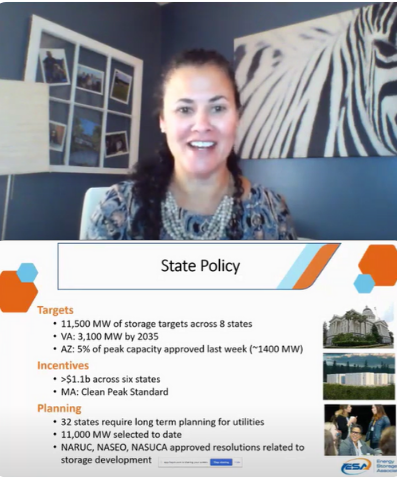
Kelly Speakes-Backman presenting at REV2020.
As federal funding for COVID recovery comes to Vermont and our leaders make choices about how to rebuild out of the pandemic, we have a once-in-a-lifetime opportunity to invest these dollars and adopt complementary policies to create a future in which both people and nature thrive.(1) Energy storage investments to modernize Vermont’s aging grid infrastructure will mitigate the costs associated with climate change, reduce climate pollution and create local jobs that put Vermonters back to work.(2)
Last November, REV2020 brought together energy storage experts who shared insights and experiences from their work outside Vermont. The day’s presentations highlighted the necessity of modernizing our power system, the critical role energy storage will play in that process, and the policies and regulations best suited to leverage private investment for the public good.
At the time of REV2020, the keynote presenter Kelly Speakes-Backman was CEO of the US Energy Storage Association. She as since been appointed to serve in the Biden administration as Principal Deputy Assistant Secretary for the Office of Energy Efficiency and Renewable Energy and Acting Assistant Secretary at the US Department of Energy. Click here to watch Kelly Speakes-Backman’s full presentation.
Key takeaways include:
- State leadership and policies drive use and access to energy storage. These policies fall into three primary buckets:
- Targets: 8 states have mandated storage procurement targets of 11,500 MW including Virginia which will achieve 3,100 MW by 2035, and Arizona which requires storage capacity equal to 5% of peak generation or approximately 1,400 MW.
- Incentives: Across six states, there are more than $1.1B in energy storage incentives, including the Massachusetts Clean Peak Standard.
- Planning: 32 states currently require that long-term planning for utilities include integrated energy storage. The three largest utility regulatory associations have approved resolutions related to energy storage development. (National Association of Regulatory Utility Commissioners, the National Association of State Energy Officers, National Association of Utility Consumer Advocates).
- There are many different business and regulatory models that can facilitate investments in energy storage and grow energy resilience.
- The most effective of these leverage private investment and third-party ownership which can be called on by utilities as well as utility-owned projects.
- Legislative direction provided to regulators creates the most effective policy environment for grid modernization which can then be paired with federal and state incentives.
- Building the 21st century grid will not only require that power be generated by 100% clean sources, but also that we are able to control when that power is available. We need both controllable distributed generation and controllable uses and loads.
- Grid congestion and grid constraints are a major problem for many states, including Massachusetts and Vermont. State policy must address this area.
- We must align broad policies such as the Renewable Energy Portfolio and Pollution Reduction targets with specific rules governing grid infrastructure and maintenance such as interconnection.
- We will not achieve 100% renewable energy without strong interconnection policy and we will need creative solutions that equitably allocate the cost of associated system upgrades. NY, MA and CA have models that allow ratepayers to contribute to the cost of grid upgrades when they receive benefits.
- A very diverse array of technologies already exist far beyond the standard battery systems which are widely available. These technologies need consistent market signals from rate design and state policy to catalyze deployment.

- Taken from the Resilient Recovery Vision Statement which REV supports.
- In 2020, energy storage employed 461 Vermonters according to the Vermont Clean Energy Industry Report.
